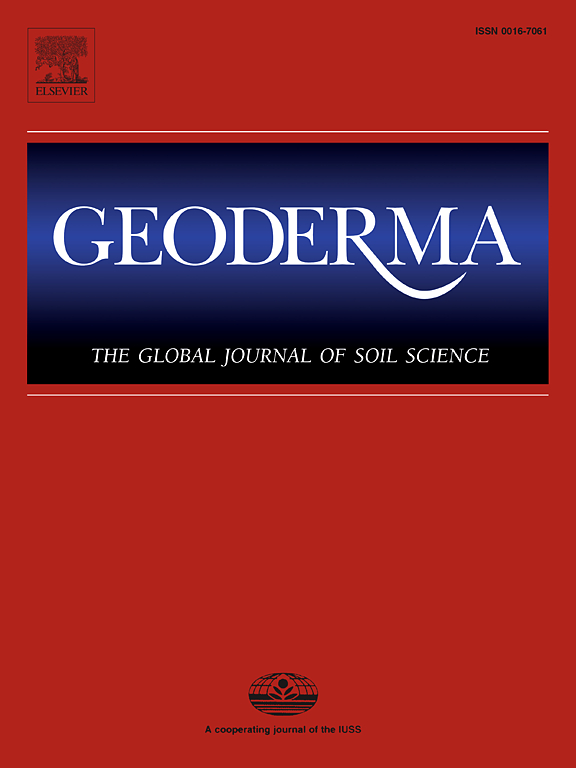Soil fauna promote litter mixture effects on nitrogen release but not carbon or phosphorus during decomposition in a subtropical forest
IF 5.6
1区 农林科学
Q1 SOIL SCIENCE
引用次数: 0
Abstract
Understanding how litter diversity drives decomposition is critical for linking plant diversity to ecosystem functioning. We conducted a 460-day field decomposition experiment using litter mixtures (1–4 species) placed in both fauna-accessible and excluded litterbags in a subtropical forest. Both additive partitioning and trait-based approaches were used to investigate the effects of litter mixing on mass loss and the release of carbon (C), nitrogen (N), and phosphorus (P). Overall, the litter mixtures exhibited limited non-additive effects on litter mass loss and C release, with significant negative selection effects that offsetting the weak complementarity effects. In contrast, N release showed strong positive net diversity effects in fauna-accessible mixtures, driven by significant complementarity and selection effects. Soil fauna amplified the diversity effect on N release but had no effect on P, which displaying primarily additive dynamics. Functional identity (community-weighted mean of leaf toughness and thickness) predominantly predicted litter mass loss and C release, while functional diversity (Rao’s quadratic entropy of litter N concentration) and identity jointly governed litter N release in the presence of fauna. Our findings demonstrate decoupled mechanisms for C and nutrient cycling, where physical traits constrain mass loss and C release while synergistic litter diversity-soil fauna interactions enhance N mineralization, highlighting context-dependent diversity effects and underscoring the importance of integrating multi-element perspectives and faunal interactions to predict biodiversity-ecosystem functioning relationships in detrital systems.
亚热带森林土壤动物促进凋落物混合对分解过程中氮释放的影响,而对碳和磷释放的影响不大
了解凋落物多样性如何驱动分解对于将植物多样性与生态系统功能联系起来至关重要。在亚热带森林进行了为期460天的野外分解实验,将凋落物混合物(1-4种)放置在动物可接近的和不存在的垃圾袋中。利用可加性分配和基于性状的方法研究凋落物混合对凋落物质量损失和碳(C)、氮(N)、磷(P)释放的影响。总体而言,凋落物混合对凋落物质量损失和碳(C)释放的非可加性影响有限,存在显著的负选择效应,抵消了弱互补效应。相比之下,N释放在动物可接近混合物中表现出强烈的正净多样性效应,这是由显著的互补效应和选择效应驱动的。土壤动物对氮释放的多样性效应增强,对磷释放的多样性效应不明显,主要表现为加性动态。功能同一性(叶片韧性和厚度的群落加权平均值)主要预测凋落物质量损失和碳释放,而功能多样性(凋落物N浓度的Rao二次熵)和同一性共同控制有动物存在时凋落物N释放。我们的研究结果证明了碳和养分循环的解耦机制,其中物理特征限制了质量损失和碳释放,而协同凋落物多样性-土壤动物相互作用增强了氮矿化,突出了环境依赖的多样性效应,并强调了整合多元素视角和动物相互作用来预测碎屑系统中生物多样性-生态系统功能关系的重要性。
本文章由计算机程序翻译,如有差异,请以英文原文为准。
求助全文
约1分钟内获得全文
求助全文
来源期刊

Geoderma
农林科学-土壤科学
CiteScore
11.80
自引率
6.60%
发文量
597
审稿时长
58 days
期刊介绍:
Geoderma - the global journal of soil science - welcomes authors, readers and soil research from all parts of the world, encourages worldwide soil studies, and embraces all aspects of soil science and its associated pedagogy. The journal particularly welcomes interdisciplinary work focusing on dynamic soil processes and functions across space and time.
 求助内容:
求助内容: 应助结果提醒方式:
应助结果提醒方式:


